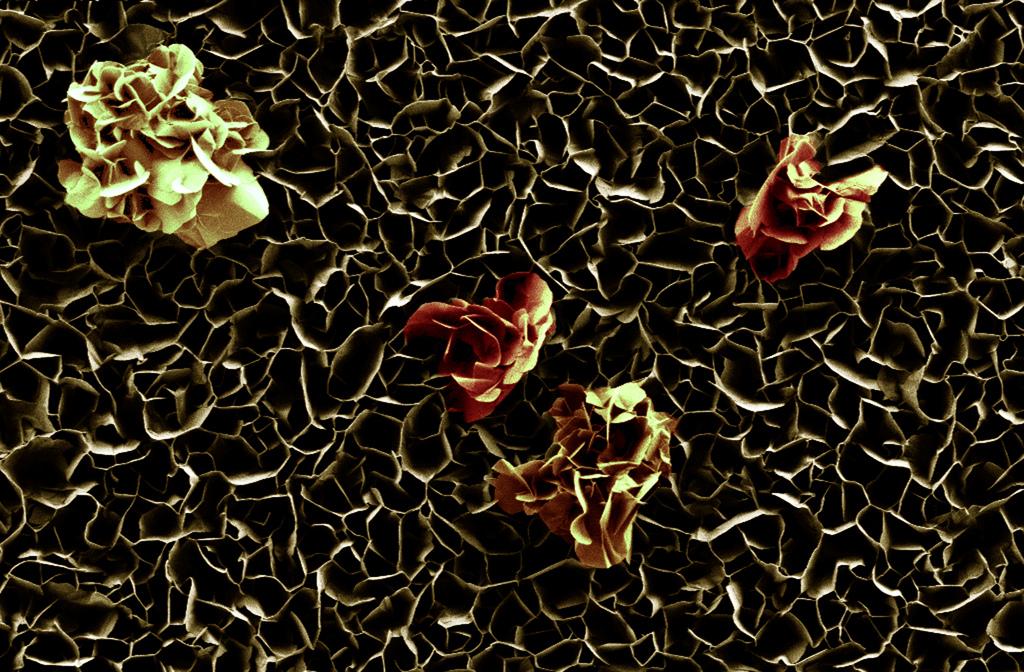Ten winning pictures at the intersection of art and science
Captured by scanning electron microscopy (SEM), these are nanoflowers made of zinc oxide (ZnO), an important semiconductor in the electronics industry. Photo by Audrey Forticaux.
Drawn from a record number of entries, 10 pictures at the intersection of art and science have been chosen as winners of the 2013 UW–Madison Cool Science Image contest.
The winning entries — chosen from a pool of 105 photos, micrographs, drawings and videos — represent a cross-section of UW–Madison research and scientific interests. Winners were chosen by a panel of eight judges, including experts in microscopy, satellite imagery and the arts.
“The diverse nature and superb quality of the science images made it very challenging to select a top 10,” says Steve Ackerman, one of the contest judges and UW–Madison Graduate School associate dean for the physical sciences.
Entries were judged by a number of criteria, including presentation, technical merit, scientific content, and the aesthetic qualities evident in the image.
The 2013 CSI contest was sponsored by Madison’s Promega Corp. with contributions from the UW–Madison Digital Media Center. The 2013 winning entries are:
—Beta Catenin, an impressionistic micrograph of a protein key to prostate development in mice and humans. Vastal Mehta, research associate in the School of Veterinary Medicine’s Department of Comparative Biosciences.
—Zebrafish Neuronal Network, a stunning micrograph depicting the network of nerves found in the tail of a zebrafish. Pui-ying Lam, graduate student, Cellular & Molecular Biology.
—Brain Image, produced by diffusion tensor imaging, a magnetic resonance imaging technique, showing the complex neural contours and pathways in a monkey’s brain. Christopher Coe, faculty, Department of Psychology.
—Middle Earth, slime mold as macroscopic “flash mob,” depicting a fantastical picture of amoebae in their social manifestation. Sheryl A. Rakowski, senior research specialist, Department of Bacteriology.
—Air Sea Interaction, a composite satellite image showing water vapor in the atmosphere and sea surface temperatures, and their role in weather, including the development of Super Storm Sandy. Rick Kohrs, senior instrument technician, Space Science and Engineering Center.
—Trichomes, a scanning electron micrograph made using a water vapor-based imaging system, showing various stages of hair or trichome development on a leaf. Emily Kief, undergraduate, Department of Botany.
—Hoodia, a macroscopic image of the center of a hoodia flower, a succulent native to South Africa and Namibia and used to teach aspects of plant geography and convergent evolution. Mo Fayyaz, distinguished faculty associate, Department of Botany.
—Lunaria Annua, a picture of the translucent silver seed pods of a plant known commonly as money plant. Kata Dosa, graduate student, Nelson Institute for Environmental Studies.
—Automeris (pain in the) Banus, picture of the stunning larval form of a tropical caterpillar just after it had stung the photographer. Peggy Boone, graduate student, Department of Zoology.
—ZnO Fall Flowers, scanning electron micrograph of zinc oxide “nanoflowers” growing on alumina, a substrate that allows ZnO to transcend its usual rod shape to take the form of flakes and flowers. Audrey Forticaux, graduate student, Department of Chemistry.
###
Tags: research, slide show





